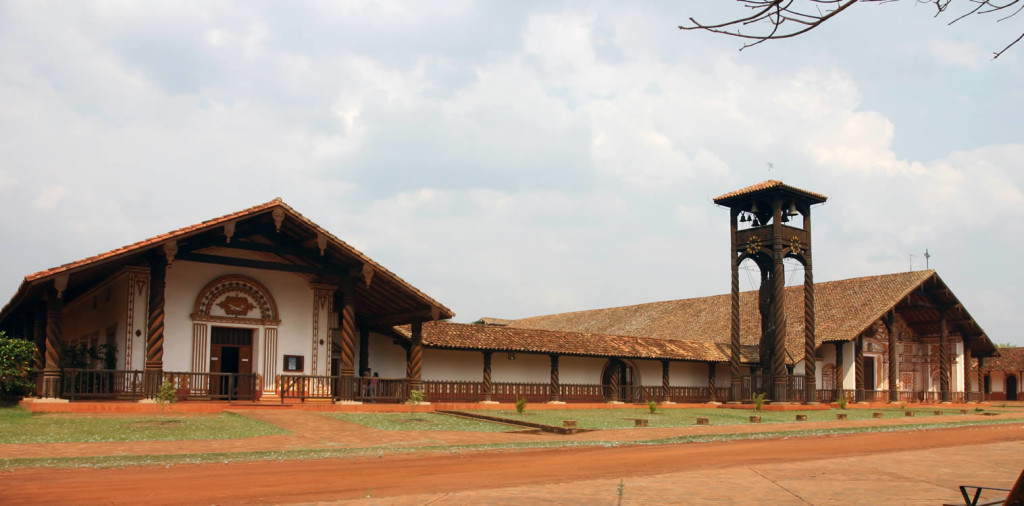Written by Geoffrey A. P. Groesbeck
Concepción was first established as the mission of La Inmaculada Concepción in 1699, although this settlement lasted only until 1704. It was re-established in 1709 (a date that some historians incorrectly claim as its founding), and incorporated the nearby ephemeral mission of San Ignacio de Boococas in 1712. Concepción was established by Jesuit missionaries Francisco Lucas Caballero and Francisco Herbás (who also co-founded San Miguel de Velasco and San Rafael de Velasco).
Caballero was killed in what was probably a case of being mistaken as a Portuguese bandeirante two years later by hostile Puyzoca. The grave of this first Jesuit martyr of the Chiquitania is unknown. The mission was moved again in 1722 by the Jesuit Juan de Benavente to its current location and soon became the cultural centre of the region, with another Jesuit, Ignacio Chomé, publishing the first Chiquitano- and Ayoreo-language dictionaries there in 1750.
As many of its original inhabitants were Chiquitano, and Concepción was one of the largest settlements, by the 1760s the Jesuits decided to make this language the lingua franca of the region, even in areas where other languages predominated. It remains the dominant indigenous language today, out of the ten still used (out of at least 36 that were spoken at the time of the Jesuits’ arrival).
In 1926, the Bolivian president Hugo Banzar was born here, and in 1951, the Apostolic Vicariate of Ñuflo de Chávez was established with Concepción as its seat.
The second stop along the traditional Jesuit Missions Circuit, many travellers consider Concepción the most enchanting town in the Chiquitania. It is roughly 174 miles (280 kms) from Santa Cruz along an asphalt road that offers some of the country’s most scenic views; on a good day the trip can be made in under four hours. Its beautiful surroundings make it a fine spot to relax, and many of its cultural and historic sites are conveniently located in the middle of town.
Its church is technically a cathedral, built by the Jesuit polymath Martin Schmid (who was responsible for the churches of San Rafael de Velasco and San Xavier and possibly San Juan Bautista) between 1752-5. Along with its nearby former convent and a rectory, which houses an artesanía and the excellent Museo Misional, it forms a marvellously harmonious architectural whole, and is a splendid example of what is termed a conjunto misional (mission complex). Its restoration began in 1975 and took more than seven years to complete.
Hidden inside the complex — you’ll have to ask for admittance — are the Episcopal Archives, which contain more than 5,000 different Jesuit music scores dating from the missionary period. Composed by well-known European artists such as Domenico Zipoli, as well as anonymous native ones, these are priceless documents that illustrate how centuries-old pieces were played, and were written in Italian, Latin, Spanish, and even Guaraní. These were discovered by the ex-Jesuit architect Hans Roth and are gradually being translated. This repository is unique in the entire Western Hemisphere.
Another recommended place is the Museo Misional, located off the plaza principal in the old cabildo (town hall). Its fascinating Hans Roth room – dedicated to the late Swiss architect who painstakingly laboured to restore the Jesuit mission churches throughout the Chiquitania showcases examples of almost-incredible detail and craftsmanship here. If you are interested in colonial architecture or restoration work, this is a mandatory stop.
There are no less than 37 indigenous communities in the area, and visits can be arranged to many of them by guides in Concepción, who can arrange a trip to some of these communities.
Concepción is famed for its orchids, considered the finest in the country. The town holds an orchid festival the second weekend of every October, the Festival Internacional de la Orquídea. More than 6,000 orchids, across almost 100 varieties, are on display at the hothouses of the Hotel Chiquitos.
Written by Geoffrey A. P. Groesbeck


